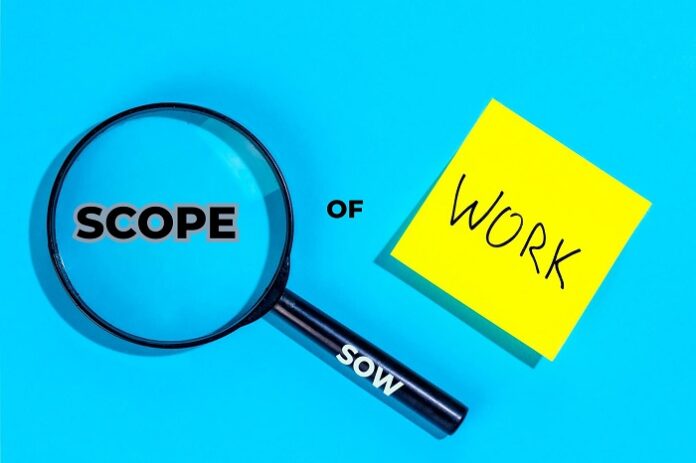The scope and description of work are often labelled by the same acronym SOW. In fact, they are quite different concepts. Scope of work template for contractors is the part of the document that specifies the ways the project will achieve certain objectives
SOW Explained
It is a reference point for staff to understand what is envisioned in the project. The scope of work outlines the basic needs and details the plan for achieving the objectives. In some cases, the SOW is not drafted if it is not considered necessary for the project. This point should be cleared with legal counsel so that disputes do not arise in the course of the project implementation.
There are various scope of work examples available online at Pandadoc. The choice should be made carefully as such a document is the core of a properly planned project. The success of implementation depends on it. Such a document will help the parties to the contract to find an agreement and identify possible risks.
It happens that when setting the scope of work, employees may discover some planned tasks that do not correspond to the current assignments. In such a case, some adjustments can be made to the contract and deadlines can be agreed upon. The employees will be able to work efficiently on the project and meet the deadline. Main advantages include:
- a clear plan;
- an understanding of the risks;
- agreement between all parties;
- accomplishing the work within the specified timeframe;
- getting the expected result;
- project success.
It is recommended to use PandaDoc tools for document management. This software has ready-made templates that can be used to draw up contracts.
Scope of Work: Features
Such a document is a working agreement between two parties. It describes the goals and objectives of a particular project. This description is based on the scope of work. Predominantly, the document is drawn up at the beginning of the project. Deadlines and other parameters of the project are necessarily taken into account.
A contract may be drafted with the involvement of external parties. For example, intermediaries between organizations and clients, buyers, agencies, or other contractors. A scope of work may often be needed when joint work is planned with designers who are engaged to accomplish project goals.
The most complex documents that include a SOW are required by government contracts. They definitely contain requests for bids or quotations. The scope of work is suitable for use in internal projects where several departments are working on it. The following parties will receive it:
- manager;
- lead specialist;
- project participants;
- contractors;
- all parties to the contract.
If you wonder whether the project requires a SOW, you should consult the legal department. This is very important because different parties are involved in the project and it must be correct. The main thing is to stipulate and agree on all the nuances.
Purposes of Using a SOW
An appropriately selected scope of work document template with efficient management tools is the key to successful project implementation. In such a document, employees can control the expected results and record all activities. A detailed project description is used to avoid misunderstandings and disagreements between the parties.
Once projects are completed, all deliverables will be recorded in the document so that they can be checked over time to determine if there is compliance with the SOW. Depending on the provisions in the contract and the results of consultation with a lawyer, the document may have other implications. It defines payment to the organization, bonuses, and penalties.
Tips for Drafting the Scope of Work
It is important to draft the scope of work correctly to help identify the main objectives for the business solution. Then it will be easy to share information that includes the project objectives. Data is shared between stakeholders.
Often, basic guidelines are used when drafting a scope of work:
- Be specific. Use precise and clear language to explain the requirements of the project and the expected deliverables. It is better to make a list of all goals and objectives in advance to avoid unforeseen situations in the future.
- Virtual elements. These can be a structure for scheduling work, simplifying the perception of information for all employees who work on the project. They help the team to identify risks and obstacles that prevent successful and timely implementation of the project.
- Collaboration among all parties. You should be sure to consult with the legal department throughout the process. Collaboration with stakeholders provides an opportunity to save time and get better results in the long run. When all parties are aware of what is going on, misunderstandings and disagreements can be eliminated at any stage.
There are no one-size-fits-all SOW templates. In order to understand what information needs to be included in a particular section and how much detail it should contain, it is important to take into account the specifics of the business activities. Any doubts can be clarified with the legal department.
In most cases, the scope of work consists of the following aspects:
- Expected Outcomes. This paragraph describes the specific product or service that will result from the successful completion of the project.
- Timeline. It is best to make a timeline or a chart accurately describing all the stages of the project. This section displays a visual map of the entire workflow so that employees and management can follow it from the very start to completion.
- Milestones. In this way, the project is broken down into more practical parts. All milestones are recorded and simplify the task of controlling processes and meeting deadlines.
- Reporting. This is an indispensable element that is included in the scope of work. There can be a report for the client or a workflow that can be requested from the supplier. Often a financial report is required to perform quality budget analysis and monitor actual performance. All documentation information is captured in this section and a person is assigned to be responsible for the entire process. The report is used to monitor communications within the project and provide all stakeholders with up-to-date information.
All aspects are carried out by the relevant staff. It is recommended to coordinate the scope of work with the legal department for the successful implementation of the project.
Image by pvproductions on Freepik





